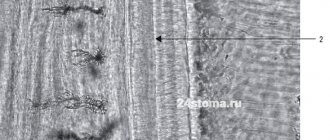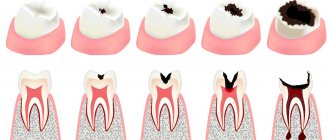How to do:
- Prepare materials for the master class: form balls of wax plasticine in the required colors.
- On a piece of paper, draw the tooth, gums and dentin outline.
- Let's start by filling in the area of dentin (the second layer of the tooth). To do this, take a piece of pink wax plasticine and, forming an outline, smear it towards the center. You don't have to worry about going beyond the intended edges, since we'll adjust them later with the next layer.
- Now we will make the enamel of our tooth. Form flagella from white plasticine and place the tooth along the contour. Then grease it up to the pink part without going beyond it.
- Form a long flagellum from yellow plasticine and lay it along the sample - this will be the pulp of our tooth.
- Smear the plasticine: note that this layer is not as thick as the previous ones. Using the tip of a stack or a pencil lead, make notches on the layer.
- Form thin flagella from red plasticine. To do this, just roll them with folded fingers on the surface of the table.
- Lay the flagella from the roots to the top of the pulp. Make them branchy. We've got blood vessels. To be precise, there are nerves inside the tooth; the vessels consist of venous and arterial ones. But we have simplified the scheme for children. If you wish, you can also add blue and yellow flagella.
- Trace the outline of the tooth with a black felt-tip pen.
- Form the contour of the gum and bone tissue. We used pink and orange markers.
- Paint over the gums, and we painted the bone tissue as pimply.
Our tooth is ready! It’s so bright, beautiful and we now know what it looks like inside!
How to make teeth for a teddy
Today my master class is dedicated to “dentures”.
I am sharing my method, which is not the only correct one, but rather one of the options. I used this method for a fixed open mouth; for a movable mouth, I most likely would have done it differently. Nevertheless, I hope this method may be useful to someone. Perhaps it will serve as an impetus to find your own version.
To sculpt the dentures, I used whatever plastic I had on hand. Other baked or self-curing plastics can be used. For self-hardening ones, an oven is therefore not needed.
You will need materials:
- Stack for modeling (optimally a metal puppet, shown in photo 1).
- The wire is thin (I used 0.5 mm thick).
- Baking plastic (I used FIMO soft, which I had on hand. You can use FIMO classic, CERNIT or another).
- The glue is durable (I used MOMENT classic universal).
- A glue stick (a wooden manicure stick is suitable for cuticles).
- Cotton thread (I used No. 10).
- A needle from a kit for sewing dolls and soft toys.
- Regular sewing needle.
- Sewing thread (I used 45LL).
- Acrylic paints (I used white and yellow).
- Acrylic varnish (can be either matte or glossy).
- Synthetic art brush (approximately No. 5-6).
- Small narrow-nose pliers (pliers with a tapered nose).
- Scissors.
- Home oven - oven.
Step 1
Important! Before sculpting, you must thoroughly knead the plastic in your hands until it becomes malleable. If the plastic breaks, it means it was poorly dented, or it is old, which will certainly have a bad effect on the work.
Step 2
We measure the length of the wire in accordance with the size of the mouth. Two pieces: for the upper and lower jaws separately. The length of the wire is equal to the length of the proposed dental “prosthesis” by 2. Fold the wire in half and twist tightly, leaving no loop at the end. This is convenient to do with the help of narrow-nosed pliers.
Step 3
We wrap the twisted pieces of wire with cotton thread so that a tail of the thread remains at the beginning of the winding. We walked from one end to the other and back, returning to the tail of the thread. Both tails of the thread were tied together so that the thread would hold and not slip. A thread wound on a wire is needed for reliable adhesion of the plastic to the frame.
Step 4
We prepared two small balls from crushed plastic for the upper and lower “prosthesis”.
Step 5
We cover the prepared wire frame with plastic. It is necessary to rub the plastic into the thread wound on the frame until it adheres, until the plastic begins to stick to the thread and becomes difficult to come off. First you form a “sausage”. Then make it flat, not too thin.
Step 6
Using a stack knife, cut out the fangs from approximately the middle of the strip relative to the horizon. Between the fangs, from their base, cut off the excess plastic (along the horizon). You are left with half a strip between your fangs.
Step 7-8
On the segment between the fangs, scratch strips (imitation teeth). Carefully seal everything with a stack and smooth out the cuts. Form the tails of the “prosthesis” using transverse pressure, not too thin.
Step 9
In the tails of the “prosthesis”, pierce holes with a needle at both ends. Bend the “prosthesis” to the “jaw” curve required for the bear.
Step 10
Ready-made prostheses. Place in the oven at 110-130 degrees for 30 minutes (for Fimo, Cernit). After baking, cool at room temperature. And it’s better to let it sit for at least 1 hour.
Step 11
Paint the “prosthetics” with a thin layer of acrylic paints to give them more natural, natural shades. After the paint has dried, apply the finishing layer - acrylic varnish. Let it dry.
Step 12
Glue the “prosthesis” by applying glue to its base, to the lower jaw. And for reliable fastening, you also sew on the tails of the “prosthesis” with super-strong thread in the color of the “prosthesis”.
Step 13-15
Sew the tongue to the lower jaw with a hidden seam. The photo shows the finished result.
Step 16
After the glue has completely set, try it on with pins and sew the lower jaw to the bear’s face with a hidden seam with super strong threads.
Happy creativity and good luck!
Use of materials for making dental molds Ganoxin Community
Jewelers are always sculpting objects and parts, most often to make wax models for casting. In the jewelry industry, there are many vulcanized rubber and silicone mold materials available for this purpose, but what if you need to make a mold outside of your well-stocked studio?
Here are two unconventional mold materials borrowed from the dental industry that will work in a pinch.
Gypsum
Jewelers have forgotten how useful plasters can be for some problems, especially duplicating bas-reliefs. My favorite serious plaster for sculpting is Vel-Mix, a material that dentists use to make very hard models of your teeth and gums. Vel-Mix works like any plaster, but it is extremely hard, strong and durable, and is so fine-grained that it reproduces the surface almost perfectly.
Gypsum is great for sculpting medallions. First, a plasticine model of the medallion is made with a relief (without undercuts) image. Then you make a wall around it using clay, wax or paper and pour in Vel-Mix. Once it has set, you simply remove the model. Before using it to create wax, soak it in water for 10 minutes to prevent the wax from sticking to it. Melt wax (injectable wax is best), pour it into the impressions and use a metal sheet to remove excess wax. (To make a thinner medallion, 1 to 2 mm thick, simply pour or blow wax into the plaster mold.) The resulting wax model will shrink slightly and can be easily removed from the Vel-Mix mold.
Ganoxin is sponsored by
Alginate
Easy to use and very inexpensive alginate compounds, available from dental, jewelry and sculpture suppliers, allow you to quickly create excellent shapes. You are probably most familiar with alginate from your experience working in the dentist's office. When the dentist puts a tray of sticky material in your mouth that hardens in a minute, he is using alginate. It provides excellent detail, is very quick to set up and is non-toxic. You mix it, pour it or spread it with a spatula onto the mold you want to mold, and wait a minute for it to set. You can then remove it from the object and pour melted injection wax into it. Once the wax has set, remove it and pour another one. You'll get six to 15 waxes out of the alginate mold before it breaks.
The mold can be stored in water for about a week. Also, if you let the mold dry, it will shrink by about 40 percent. If you wet it after it has set, you may end up with a reduced size wax, which can be interesting.
Together with
Award-winning Journal
is published monthly by MJSA, a trade association of professional jewelry manufacturers, designers and other suppliers. It offers design ideas, manufacturing and manufacturing techniques, bench testing tips, business intelligence and marketing information, as well as the latest news on trends and technology—essential information for business success.
“More than other publications,
MJSA Journal caters to people like me: those trying to make a living designing and making jewelry,” says
Jim Binnion of James Binnion Metal Arts.
Click here to read our latest articles Click here for a FREE four-month trial.
Modeling teeth from plasticine
Plasticine is perhaps the most common material; it is easily accessible and does not require special preparation for work. Having taken the required amount, just warm it up, knead it in your hands - and you can start working. Having no experience working with this material, in the first stages it is better to work without tools to feel its properties, and then create shapes using tools. After kneading, the plasticine is ready for modeling, but it does not need to be heated for long, as it becomes too soft, sticky and will not hold its shape well.
Let's consider the main stages of modeling tooth 36 from plasticine. We give the plasticine the shape of a ball (photo 29). Having outlined the main surfaces and tops of the tubercles of the future model, we deepen the first-order fissure of the F-shaped form. As a result, five cusps are formed on the chewing surface (photo 30): (1) anterior lingual, (2) posterior lingual, (3) anterior buccal, (4) posterior buccal, (5) distal. Using the tool (Fig. 31), modeling of the distal ridge (B), longitudinal ridge (A), medial ridge (C), anterior lingual tubercle (1) and modeling (photo 32) of the medial ridge (B), longitudinal ridge (A), distal ridge (C), posterior lingual tubercle (2).
Fangs made of clay or plasticine
How to make fangs from polymer clay or hardening plasticine with your own hands? If you build up teeth sculpted from plasticine or clay, even those made at home
they will look no worse than store-bought ones. Environmentally friendly plasticine can be purchased in any children's goods department. Unlike clay, it hardens on its own within twenty minutes and does not require heating in an oven.
White plasticine should be mixed with a small amount of yellow to obtain a more natural color. From the resulting mass, you need to sculpt two fangs of an elongated, flattened shape, approximately twice as long as your own. It is better to attach it with dental wax or nail glue.
Necessary materials:
- Clay or plasticine;
- Modeling kit;
- Dental wax or glue.
It is important to remember that with any method of growing teeth like a vampire at home, you should follow simple hygiene rules. And also do not forget that fangs are teeth number three, if you count from the center.
Tooth modeling is a revolutionary breakthrough in dentistry
Dentistry does not stand still. New technologies are constantly emerging that contribute to better dental restoration.
Innovative techniques in the field of dentistry include modeling. It allows you to achieve a perfect match between the dentures and the teeth. With the help of modeling, it is possible to reproduce as accurately as possible the anatomical shape and functioning features of the dentition, as well as to ensure a high degree of aesthetics of the oral cavity.
Missing tooth? Prosthetic options for one tooth
You've lost one tooth and now you need to find a way to replace it. You can simply leave it as is, but you risk developing problems that could affect your health and well-being.
For example, depending on where the gap in your mouth is from a missing tooth, it can affect your smile and appearance.
Or the rupture may lead to problems drinking, eating and speaking. You may have trouble sleeping, and this will generally affect your alertness and your behavior during the day.
However, there are several different single tooth denture options to provide a temporary or permanent solution to a missing tooth. Here we discuss some of the different artificial tooth options available:
FIMO Soft Clay
You can spend as little as $5 on a package of FIMO soft clay and do what Henry Kroll did. He posted a short video on YouTube in which he took clay, shaped it into teeth, baked it until it hardened, and then glued the teeth into place.
He doesn't recommend gluing them yourself like he does, but you can still watch his video here:
Make your own dentures with DVD instructions
Another way to make a single tooth denture is to use about $25 worth of materials that you can find around your house. Gary Rhyne has developed a kit that you can order online that will include DVDs with instructions on how to make your own dentures.
Basically, all you have to do is mold the gums using plaster of paris. You then sculpt wax on top of the plaster mold to get the proper fit. You then fit the teeth into place (which you order online from Rhyne). Using dental wax to hold the teeth in place ensures a good fit in the mouth and holds the acrylic denture teeth in place.
See Gary's YouTube video below:
Cheap Single False Tooth Using Craft Beads
Craft resin beads at an art store will cost you about $12.
If you add them to a glass of hot water, they will become soft enough to be molded into the shape of a tooth or teeth by hand. A warm butter knife helps shape and once you have the desired shape, trim it with scissors. This makes a realistic single artificial tooth that you can use until you see a dentist.
To see how to do this online, watch this video:
Temptooth Temporary Tooth Replacement
Another option for melting beads is a product called Temptooth.
Similar to the bead project above, you melt the beads and hand shape them into a denture shape for one tooth. Once cooled, it turns white and can be colored to match the rest of your teeth.
As the name suggests, it is nothing more than a quick fix to create a “temporary” tooth for a short period of time. But this can give a good result, which may be enough until you see a dentist.
Find out more about Temptooth here.
Which single denture option is better?
Since there is no such thing as a one-size-fits-all denture replacement, you must examine each one to find the best one to replace your missing tooth.
You can easily use one of the DIY options until you can see your dentist for a more permanent replacement, which is why we've included them here. DIY options can be great if you need a single tooth option in a hurry, or you're a little short on funds and need an affordable option to keep you going until you can see your dentist. DIY dentures are generally much less expensive than professional dentures, which is one of the main reasons why they are popular.
It is best to consult your dentist before choosing a replacement. Your dentist will be able to help you weigh the pros and cons, costs, and what will work best for you based on your lifestyle and budget.
More from my site
Plasticine tooth. Step by step modeling.
How much time, nerves and effort parents spend trying to persuade their child to go to the dentist. But this procedure is extremely necessary, because all adults know about the consequences that can arise if caries is not noticed in time. But how can we explain this to children? All kids are terrified of doctors, and even more so of dentists.
We invite you to experiment and turn futile persuasion into an exciting game. Make your teeth out of plasticine. On the one hand, you will have fun and useful time with your children, on the other hand, you will tell them important information and prove that going to the dentist is extremely necessary. In this sculpting lesson we will show you how to sculpt teeth from plasticine. Let's give them a funny cartoon look. One of our teeth will be healthy - with a smile, the other - sad and sick with caries. So, let's start our experiment.
To sculpt teeth from plasticine you will need:
- white plasticine - first of all;
- grey, blue and black - little crumbs of additional shades;
- stack - a sharp plastic instrument.
1. Naturally, the teeth should be white, so only this color is suitable for work, unless, of course, you are going to depict gold or silver crowns.
2. Let's make two teeth, so you should divide the block in half and roll two balls.
3. Pull the beads into standard drops.
4. Cut the sharper part of each volumetric workpiece to show the tooth root.
5. Make the wider part flat and similar to the surface of the tooth using your fingertips.
6. Leave one tooth – a healthy one – unchanged, the second one – stripe the top with a glass and attach a small gray spot.
7. So, our first tooth is healthy and happy. Attach the eyes and make a stacked smile.
8. The second tooth has caries and is sad. Attach the eyes and make a stack of sad expressions on the face.
This is what a dental fantasy turned out to be. Now is the time to come up with a fascinating tale about two white brothers, one of whom was terribly afraid of dentists. Most likely, the child will immediately understand which tooth we are talking about.
moy-karapuzik.ru
Wax-up modeling stages
The dental Wax-up modeling process takes place in several stages:
- a plaster or silicone impression of the client’s jaw is taken not only where they will be temporarily placed, but also on the opposite side;
- fixing the jaw from closing by using silicone bite ridges;
- creating jaw samples using a special plate (face bow) attached to the ears;
- Having received the samples, they are transferred directly to the gypsum material;
- fixing the reproduced model on an articulator - a device that simulates jaw functions and allows the technician to establish chewing and articulatory movements;
- modeling a wax cast on plaster models and demonstrating it to the client.
In cases where the mock-up is converted to the Mock-up technique, the resulting sample is transferred into the oral cavity and the following manipulations are carried out:
- receive silicone keys, that is, an impression from new units;
- deposits (plaque, stone) are eliminated without grinding or preparation;
- fix the layout using special glue;
- placing plastic or composite material in impressions and applying it to the teeth;
- removing silicone keys and processing them by grinding and polishing;
- The final point is to evaluate the work performed.
The duration of creating a wax model, depending on the specific structure of the jaw and the location of the procedure, ranges from 20 to 60 minutes.
Fangs made from artificial nails
How to easily make vampire teeth or fangs from artificial nails with your own hands? To grow such fangs at home, you will need to purchase a set of artificial nails from a cosmetic store. It is preferable to choose beige or milky nails. Depending on the size of your own teeth, you need to select two nails from the set. Using scissors and a nail file, give them a cone-shaped, pointed shape. Next, try it on in front of a mirror and adjust the length if necessary. It is better to trim and file the nail over a spread newspaper, so as not to litter the room. Nail glue should be used with caution, as in large quantities it can damage the enamel. It is best to use dental or base wax for fastening.
As a replacement for nails, you can cut plastic pads from scrap material. A white jar of vitamins or a plastic cup are perfect for growing fangs at home, like a real vampire. To do this, you need to cut out two pads from plastic and attach them using one of the above methods.
Necessary materials:
- A set of artificial nails (white plastic as a replacement);
- Scissors;
- Nail file;
- Dental wax or nail glue.
Methodological approaches to dental modeling
“Step by step you gradually descend into a world beyond your gaze!”
From Shinto philosophy
“Going there without knowing where and doing that without knowing what” is a difficult task! This applies to almost all areas of our lives, including dentistry. Even if you imagine the future design of the tooth being restored, your hands do not always correctly reproduce its shape and volume. Students of the art and graphics department are taught that “one hundred still lifes must be written in order for the one hundred and first to turn out correctly”! Unfortunately, while receiving higher professional education at universities, students of the Faculty of Dentistry acquire limited knowledge about the shape of teeth. An insufficient number of hours are devoted to reproducing teeth using hand-made materials (clay, plasticine, plastic). But the correctness of the newly created forms is the path to the solution to harmony!
The ability to correctly restore the shape of missing hard dental tissues is of paramount importance in clinical dentistry. The dentist's hands are the main tool for modeling teeth! You can develop this skill through artistic modeling classes. The purpose of the classes is to develop visual memory, manual skills, creative thinking and the ability to perceive shapes in space. Anyone who wants to know the stages of recovery can begin the first exercises with a minimum of conditions - material and simple tools.
Dental modeling is a creative process where, in addition to knowledge of anatomy, there must be freedom in choosing the material from which models can be created. Before you start work, you need to familiarize yourself with the basic properties of materials and choose which one is more suitable for you.
When carving, excising a form from solid materials - wood, stone and others - the sculptor gradually, step by step, cuts off the material, freeing the form enclosed in it. This technique is also widely used in therapeutic dentistry, for example, the stage of contouring the surface of a filling.
Modeling is the making of sculpture from soft materials. For modeling, you can choose any material that has plasticity. It can be plasticine, sculpture clay, plastic, wax.
Plasticine tooth. Modeling lesson.
For children, dental treatment is a hot topic, especially if you do not convey important information to them about why they need to monitor the condition of their mouth. The first and most important thing that parents should teach their children is daily hygiene and brushing their teeth. We invite you to make a cute craft with your preschool children - a tooth. It will become a visual aid in which you can show your child the importance of healthy teeth for the body. This is a great way to conduct an interesting educational lesson. Come up with a story about healthy and sick teeth, and you can learn the sculpting process from our master class. As you all already guessed, today we will tell you how to make a tooth from plasticine.
1. Prepare about a third of a block of white plasticine for work and a tool for cutting the material.
№1
2. Roll out an oval piece - the basis of the future tooth.
№2
3. Cut across the bottom to expose the roots. These will be the legs of our tooth man.
№3
4. Finish shaping the figure by lightly pressing the top surface with your finger.
№4
5. Make the white man cheerful by attaching eyes, a nose and a smiling mouth.
№5
6. Attach two white plasticine handles to the sides.
№6
7. You need to show that the tooth loves to bathe and clean itself with a brush and toothpaste. Roll out three multi-colored strips.
№7
8. Intertwine them together to form a three-color toothpaste.
№8
9. Apply some paste to the crown of your head.
№9
10. Also make a brush from white and any other plasticine. Place a match at the base of the holder, and mark the bristles with a stack.
№10
11. Insert the brush into the tooth man's hand, now he is ready to go for cleaning.
The final look of the craft.
This funny craft can show off on a shelf in the bathroom and remind your child why he needs to brush his teeth every morning and evening. Such a little person will be happy to decorate a jar for storing toothbrushes.
podelkisvoimirukami.ru
Tags
Dental laboratory Dental laboratory modeling teeth from reproducing teeth from Fig. Rice. Rice. Rice. Rice. Rice. Rice. Rice. Rice. Rice. Distal tuberclemodeling of the distal ridgeModeling of the distal ridgecenter distal Distal cuspmodeling of the distal ridgeModeling of the distal ridgemodeling of the distal ridge distal contactto modeling teeth
tubercle buccal vestibular time palatal outline fissure contact marking filling giving introductory tests shaped formation possibility of such crowns treatment









